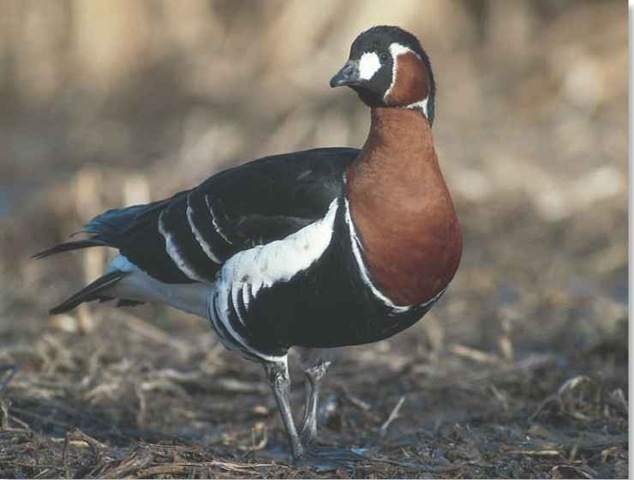ORDER
Anseriformes
FAMILY
Anatidae
GENUS & SPECIES
KEY FEATURES
• Nests near larger birds of prey to protect its eggs from foxes and other predators
• Breeds on narrow stretch of land in the far reaches of harsh Siberia
• Thick-necked and short-billed, the red-breasted goose is smaller than most other geese
WHERE IN THE WORLD?
Found mainly on Siberia’s Gyda and Taymyr peninsulas; winters around the Black Sea, especially in Romania, with scattered numbers in Greece and Iran
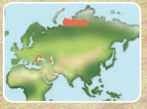
Lifecycle
The red-breasted goose occupies a narrow breeding ground on the tundra of Siberia, where it relies on birds of prey to help it guard against predators.
HABITAT
The restricted breeding grounds of the red-breasted goose consist mostly of moss- and lichen-covered tundra and brush tundra, mainly on the Gyda Peninsula and the western part of the Taymyr Peninsula in Siberia. During the nesting season, the birds seem to prefer the driest and highest areas of tundra and brush, staying close to the water. In
the winter, they often occupy low-lying regions around lakes or reservoirs where herbs and grasses are easy to find.
Pretty paddlers A graceful swimmer, the red-breasted goose winters on lakes or reservoirs.

CONSERVATION
There has been an alarming decline in the number of red-breasted geese during the last few decades, from an estimated 50,000 birds in the mid-1950s to a recent decline to 20,000. The decline of this species is related to the decline in birds of prey, especially the peregrine falcon, Falco peregrinas, due to the excessive use of pesticides in recent decades. The red-breasted goose nests very close to the nests of these birds as a defense mechanism against foxes. The decline in peregrine populations has led to a similar decline in goose numbers. The red-breasted goose remains vulnerable to illegal hunting, changes in land use and pollution; also, their breeding areas continue to be disrupted by oil and gas exploration.
BREEDING
Red-breasted geese breed during the summer months, usually during the first half of June. During this relatively mild season, snow on the tundra is starting to melt, and new grasses for nestlings to feed on are beginning to sprout. Courting behavior is highly ritualized, involving mutual head-dipping alternated with a very erect posture as the male and female face each other. The birds build a shallow nest of vegetation, lined with down, on steep river banks, low rocky crags or gullies, with cover such as dwarf birch, willow or tall dead grass. The nests are built near those of birds of prey, such as peregrine falcons. As the much larger and stronger birds protect their own nests, the falcons also help the defenseless geese protect their broods.
The normal clutch size is typically 6-7 eggs. Incubation is performed by the female alone, but the male remains nearby throughout the 23-25-day incubation period. Chicks typically begin hatching by the end of July and are flying by the end of August, suggesting a short fledging period.
RED-BREASTED RESOURCEFULNESS

Safety in numbers…
The red-breasted goose builds its nest close to larger birds of prey, such as the rough-legged buzzard (Buteo lagopus).
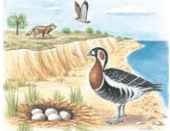
Buzzard bombardier…
A nervous mother guards her precious nest as the rough-legged buzzard attacks an invading Arctic fox that is on the prowl.
FOOD & FEEDING
Essentially a vegetarian, the red-breasted goose’s diet consists of the leaves, stems and green parts of grasses and aquatic plants. During its summer breeding season, the red-breasted goose enjoys cotton grass, which sprouts at about the time they begin nesting. They also eat sprouting wheat and wild garlic tubers. In their winter quarters, they fly to watering holes to drink and obtain sand for their gizzards; the sand acts as a grinding mechanism to aid digestion. The geese return to steppelike areas to eat grasses and herbs.
Foraging flock A flock of red-breasted geese forages for grass.
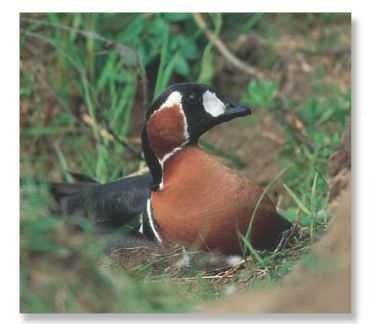
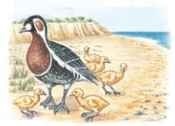
Goose stepping…
A new parent leads her unorganized parade of five curious chicks, which are eager to explore new territory around the nesting site.
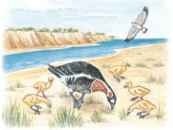
Eye in the sky
A rough-legged buzzard flies patrol of its own nest as a hungr) family of red-breasted geese forage for grass below.
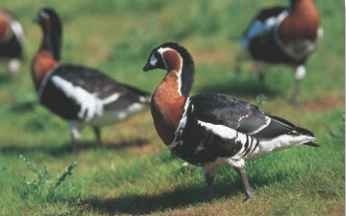
• On October 10, 1998, the Ukraine issued a set of four colorful postage stamps depicting the red-breasted goose; the four stamps depict the various activities of the red-breasted goose.
The beautiful goose is known by many other names. Rothalsgans is its German name, while in French it is known as bernache a cou roux and its Spanish name is ganso de pecho rojo.
BEHAVIOR
In spite of its small size, the red-breasted goose is highly vocal and relatively aggressive among its own kind. When provoked by other red-breasted geese, for instance, the red-breasted goose makes a formidable sight as it menacingly vibrates the feathers surrounding its neck and head.
Dazzling display The goose’s glorious plumage makes it uniquely beautiful.
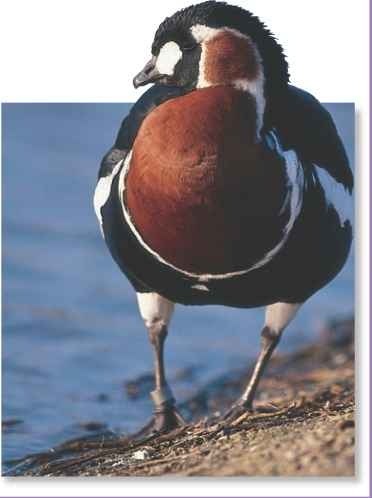
PROFILE
Red-breasted Goose
With its brilliant copper-colored plumage, the red-breasted goose stands in sharp contrast to the stark, rugged
Siberian landscape.
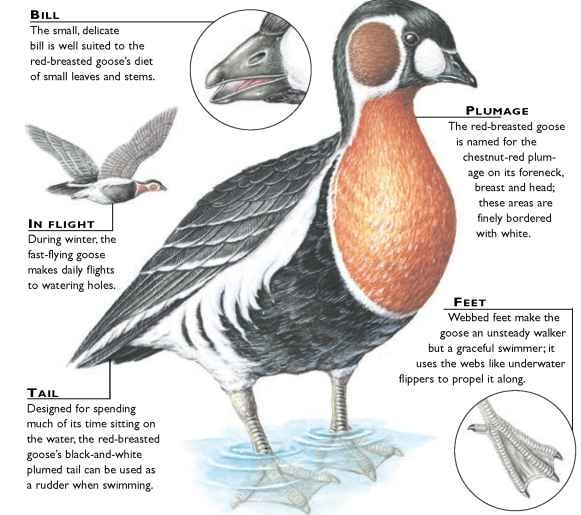
CREATURE COMPARISONS
At 28″, the emperor goose (Anser conagicas) is larger than the red-breasted goose. While both birds have distinct coloration, the emperor goose lacks the rich reddish-chestnut coloration of its relative; the emperor goose has a white head and back of the neck, with otherwise gray-to-black plumage. While the emperor goose is an Alaskan and eastern Siberian goose that winters in the Arctic seas, it is rarely found south of Alaska. The red-breasted goose is found almost entirely within the Taymyr Peninsula in the Siberian tundra and winters mostly around the Black Sea.
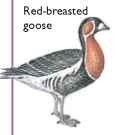
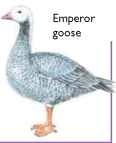
| VITAL STATISTICS | |
| Weight | 2.5-3.5 lbs. |
| Length | 20-22″ |
| Wingspan Sexual Maturity |
45-53″ |
| 3-4 years - | |
| Breeding Season | Summer; begins in June and -chicks fledge by August |
| Number of Eggs | 3-7; usually 6 or 7 |
| Incubation Period | 23-24 days |
| Fledging Period | 35-60 days |
| Breeding Interval | Yearly |
| Typical Diet | Leaves, stems, green grasses |
| Lifespan | Unknown |
RELATED SPECIES
The red-breasted goose is 1 of 5 species in the genus Branta. Distribution of this wide-reaching genus spans the globe, ranging from the Hawaiian goose, Branta sandvicensis, found in Maui, to the barnacle goose, Branta leucopsis, found in Greenland. There are about 147 species in the Anatidae family, which includes such birds as ducks, geese, mergansers and stifftails.
